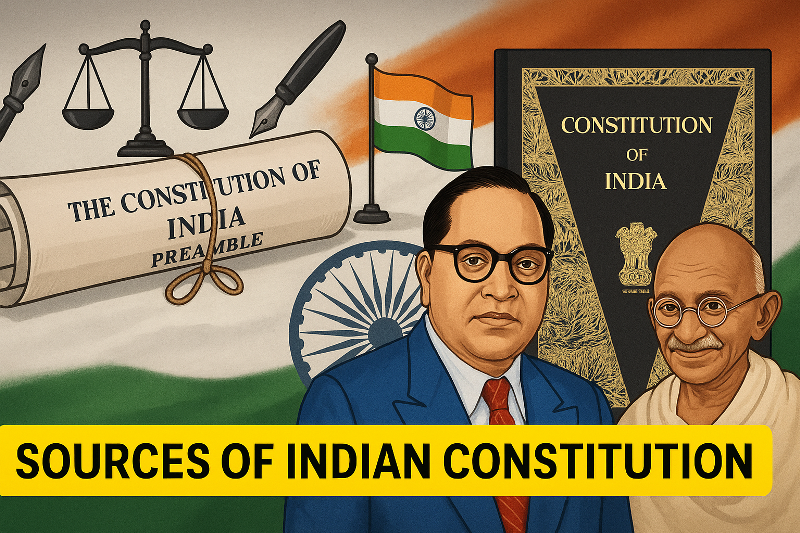
Making of the Constitution of India | Key Facts, Dates & Personalities (NCERT)
Detailed NCERT-based notes on the making of the Indian Constitution – key dates, committees, Ambedkar’s role, Objective Resolution, and adoption process.
The making of the Indian Constitution was a historic process rooted in India’s freedom struggle and aspirations for democracy. After years of colonial rule, the demand for Swaraj (self-rule) led to the formation of the Constituent Assembly in December 1946, under the Cabinet Mission Plan. The Assembly had 389 members initially, later reduced to 299 after the partition of India. Dr. Rajendra Prasad was elected as the President of the Constituent Assembly, while Dr. B.R. Ambedkar chaired the Drafting Committee formed on 29 August 1947. On 13 December 1946, Jawaharlal Nehru introduced the Objective Resolution, which laid down the vision and values that would shape the Constitution and later became the basis of the Preamble. The Constitution borrowed features from countries like the UK, USA, Ireland, and Canada, while ensuring it reflected India’s unique diversity. After nearly 3 years of detailed debates and discussions, the final Constitution was adopted on 26 November 1949 and came into effect on 26 January 1950. This date was chosen to honor the declaration of Purna Swaraj made in 1930. The Indian Constitution became the world’s lengthiest written Constitution and established India as a Sovereign, Socialist, Secular, Democratic Republic, ensuring justice, liberty, equality, and fraternity for all citizens.

1. Historical Background
Indian leaders demanded Swaraj (self-rule) since the early 1900s.
The Indian Constitution was framed in the backdrop of colonial rule, freedom struggle, and the aspiration for self-rule.
British colonialism exploited Indian resources and denied civil rights to Indians.
2. Formation of the Constituent Assembly
Members were indirectly elected by Provincial Legislative Assemblies.
Proposed under the Cabinet Mission Plan (1946).
Constituent Assembly first met on 9 December 1946.
Initially had 389 members, but after partition, the number was reduced to 299.
3. Objective Resolution (22 January 1947)
- Moved by Jawaharlal Nehru.
- It outlined the ideals and philosophy of the Constitution.
- It later became the basis of the Preamble.
Main ideas:
Safeguards for minorities, backward and tribal people.
Independent, sovereign republic.
Justice, equality, freedom of thought and expression.
4. Drafting Committee
Other members: Alladi Krishnaswamy Iyer, K.M. Munshi, N. Gopalaswami Ayyangar, B.L. Mitter, etc.
Constituent Assembly formed 22 committees for various tasks.
The most important was the Drafting Committee, formed on 29 August 1947.
Chairman: Dr. B.R. Ambedkar
5. Role of Dr. B.R. Ambedkar
Ensured protection of Fundamental Rights and Minority Rights.
Known as the “Father of the Indian Constitution”.
Advocated for social justice, equality, and constitutional morality.
6. Sources of the Indian Constitution
| Feature | Borrowed From |
|---|---|
| Parliamentary system, Rule of Law | United Kingdom |
| Fundamental Rights, Judicial Review | United States |
| Directive Principles | Ireland |
| Federal System | Canada |
| Emergency Provisions | Germany |
| Procedure of Amendment | South Africa |
7. Adoption of the Constitution
- Draft Constitution completed: November 26, 1949.
- It took 2 years, 11 months, 18 days to complete.
- Came into effect on 26 January 1950 (chosen to commemorate 1930 Purna Swaraj Day).
- On this day, India became a Republic.
8. Features of the Indian Constitution
- Lengthiest written constitution in the world.
- Federal in structure, unitary in spirit.
- Parliamentary form of government.
- Independent judiciary.
- Fundamental Rights and Duties.
- Directive Principles of State Policy.
- Single citizenship.
- Secular, Socialist, Democratic Republic.
Key Personalities Involved
| Name | Role |
|---|---|
| Dr. Rajendra Prasad | President of the Constituent Assembly |
| Dr. B.R. Ambedkar | Chairman of Drafting Committee |
| Jawaharlal Nehru | Presented the Objectives Resolution |
| Sardar Patel | Worked on integration of princely states |
| B.N. Rau | Constitutional Adviser |
Important Dates to Remember
| Date | Event |
|---|---|
| 9 December 1946 | First meeting of Constituent Assembly |
| 13 December 1946 | Nehru presented Objective Resolution |
| 29 August 1947 | Drafting Committee formed |
| 26 November 1949 | Constitution adopted |
| 26 January 1950 | Constitution came into force (Republic Day) |
When was the Constituent Assembly formed?
Answer: The Constituent Assembly was formed on 9th December 1946 under the Cabinet Mission Plan of 1946.
Who was the President of the Constituent Assembly?
Answer: Dr. Rajendra Prasad was elected as the President of the Constituent Assembly.
Who is called the 'Father of the Indian Constitution
Answer: Dr. B.R. Ambedkar, the Chairman of the Drafting Committee, is known as the Father of the Indian Constitution.
When was the Constituent Assembly formed?
Answer: The Constituent Assembly was formed on 9th December 1946 under the Cabinet Mission Plan.
Who was the President of the Constituent Assembly?
Answer: Dr. Rajendra Prasad was elected as the President of the Constituent Assembly.



